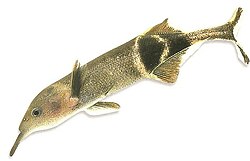Fish intelligence is "the resultant of the process of acquiring, storing in memory, retrieving, combining, comparing, and using in new contexts information and conceptual skills"[1] as it applies to fish. Due to a common perception amongst researchers that Teleost fish are "primitive" compared to mammals and birds, there has been much less research into fish cognition than into those types of animals, and much remains unknown about fish cognition, though evidence of complex navigational skills such as cognitive maps is increasing.[2][3]
Compared to similarly sized fish, mammals and birds typically have brain sizes fifteen times larger, though some species of fish such as elephantnose fish have very large brain-to-body ratios. However, fish still display intelligence that cannot be explained through Pavlovian and operant conditioning, such as reversal learning, novel obstacle avoidance, and passing simultaneous two-choice tasks.[4] Some fish also match mammals and birds in the executive functioning capability of inhibitory motor control.[5] Furthermore, some fish also have an oxytocin-enabled ability to sense another's fish's fear. Australian biologist Culum Brown has argued that fish may give the appearance of being less intelligent than they are due to differences between aquatic and terrestrial environments.[6]
Fish hold records for the relative brain weights of vertebrates. Most vertebrate species have similar brain-to-body mass ratios. The deep sea bathypelagic bony-eared assfish[7] has the smallest ratio of all known vertebrates.[8] At the other extreme, the electrogenic elephantnose fish, an African freshwater fish, has one of the largest brain-to-body weight ratios of all known vertebrates (slightly higher than humans) and the highest brain-to-body oxygen consumption ratio of all known vertebrates (three times that for humans).[9]
- ^ Humphreys, L.G. (1979). "The construct of general intelligence". Intelligence. 3 (2): 105–120. doi:10.1016/0160-2896(79)90009-6.
- ^ Rodríguez, Fernando; Quintero, Blanca; Amores, Lucas; Madrid, David; Salas-Peña, Carmen; Salas, Cosme (August 11, 2021). "Spatial Cognition in Teleost Fish: Strategies and Mechanisms". Animals. 11 (8): 2271. doi:10.3390/ani11082271. ISSN 2076-2615. PMC 8388456. PMID 34438729.
- ^ Cite error: The named reference
:0was invoked but never defined (see the help page). - ^ Aellen, Mélisande; Burkart, Judith M.; Bshary, Redouan (March 14, 2022). "No evidence for general intelligence in a fish". Ethology. 128 (5): 424–436. Bibcode:2022Ethol.128..424A. doi:10.1111/eth.13275. ISSN 0179-1613.
- ^ Lucon-Xiccato, Tyrone; Gatto, Elia; Bisazza, Angelo (October 13, 2017). "Fish perform like mammals and birds in inhibitory motor control tasks". Scientific Reports. 7 (1): 13144. Bibcode:2017NatSR...713144L. doi:10.1038/s41598-017-13447-4. ISSN 2045-2322. PMC 5640690. PMID 29030593.
- ^ Stromberg, Joseph (2014-08-04). "Are fish far more intelligent than we realize?". Vox. Retrieved 2024-03-13.
- ^ Froese, Rainer; Pauly, Daniel (eds.). "Acanthonus armatus". FishBase. January 2014 version.
- ^ Fine ML, Horn MH and Cox B (1987) "Acanthonus armatus, a Deep-Sea Teleost Fish with a Minute Brain and Large Ears" Proceedings of the Royal Society B, 230(1259)257-265.
- ^ Nilsson, Göran E. (1996). "Brain And Body Oxygen Requirements Of Gnathonemus Petersii, A Fish With An Exceptionally Large Brain" (PDF). The Journal of Experimental Biology. 199 (3): 603–607. doi:10.1242/jeb.199.3.603. PMID 9318319.

